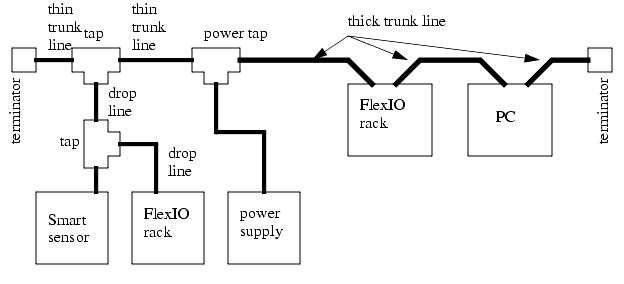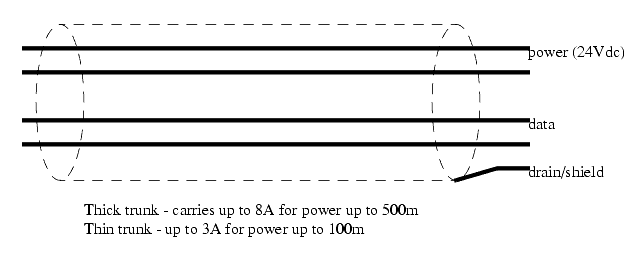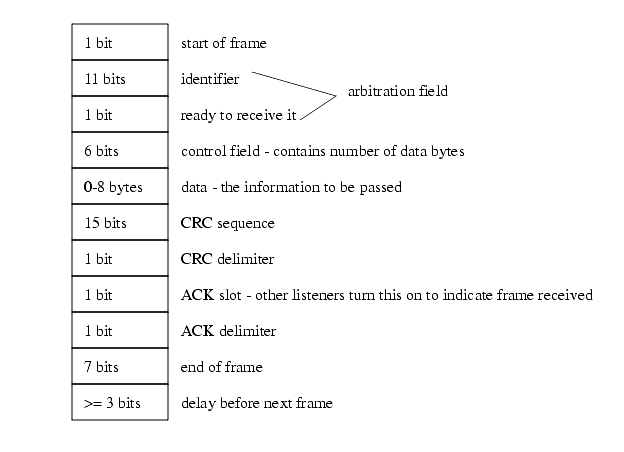
|
|
|
13.1 OPEN NETWORK TYPES
������������13.1.1 Devicenet
������������Devicenet has become one of the most widely supported control networks. It is an open standard, so components from a variety of manufacturers can be used together in the same control system. It is supported and promoted by the Open Devicenet Vendors Association (ODVA) (see http://www.odva.org). This group includes members from all of the major controls manufacturers.
This network has been designed to be noise resistant and robust. One major change for the control engineer is that the PLC chassis can be eliminated and the network can be connected directly to the sensors and actuators. This will reduce the total amount of wiring by moving I/O points closer to the application point. This can also simplify the connection of complex devices, such as HMIs. Two way communications inputs and outputs allow diagnosis of network problems from the main controller.
Devicenet covers all seven layers of the OSI standard. The protocol has a limited number of network address, with very small data packets. But this also helps limit network traffic and ensure responsiveness. The length of the network cables will limit the maximum speed of the network. The basic features of are listed below.
An example of a Devicenet network is shown in Figure 22.16. The dark black lines are the network cable. Terminators are required at the ends of the network cable to reduce electrical noise. In this case the PC would probably be running some sort of software based PLC program. The computer would have a card that can communicate with Devicenet devices. The 'FlexIO rack' is a miniature rack that can hold various types of input and output modules. Power taps (or tees) split the signal to small side branches. In this case one of the taps connects a power supply, to provide the 24Vdc supply to the network. Another two taps are used to connect a 'smart sensor' and another 'FlexIO rack'. The 'Smart sensor' uses power from the network, and contains enough logic so that it is one node on the network. The network uses 'thin trunk line' and 'thick trunk line' which may limit network performance.

The network cable is important for delivering power and data. Figure 22.17 shows a basic cable with two wires for data and two wires for the power. The cable is also shielded to reduce the effects of electrical noise. The two basic types are thick and thin trunk line. The cables may come with a variety of connections to devices.

Some of the design issues for this network include;
If a PLC-5 was to be connected to Devicenet a scanner card would need to be placed in the rack. The ladder logic in Figure 22.18 would communicate with the sensors through a scanner card in slot 3. The read and write blocks would read and write the Devicenet input values to integer memory from 'N7:40' to 'N7:59'. The outputs would be copied from the integer memory between 'N7:20' to 'N7:39'. The ladder logic to process inputs and outputs would need to examine and set bits in integer memory.

On an Allen Bradley Softlogix PLC the I/O will be copied into blocks of integer memory. These blocks are selected by the user in setup software. The ladder logic would then using integer memory for inputs and outputs, as shown in Figure 22.19. Here the inputs are copied into N9 integer memory, and the outputs are set by copying the N10 block of memory back to the outputs.

13.1.2 CANbus
������������The CANbus (Controller Area Network bus) standard is part of the Devicenet standard. Integrated circuits are now sold by many of the major vendors (Motorola, Intel, etc.) that support some, or all, of the standard on a single chip. This section will discuss many of the technical details of the standard.
CANbus covers the first two layers of the OSI model. The network has a bus topology and uses bit wise resolution for collisions on the network (i.e., the lower the network identifier, the higher the priority for sending). A data frame is shown in Figure 22.20. The frame is like a long serial byte, like that seen in Figure 22.3. The frame begins with a start bit. This is then followed with a message identifier. For Devicenet this is a 5 bit address code (for up to 64 nodes) and a 6 bit command code. The 'ready to receive it' bit will be set by the receiving machine. (Note: both the sender and listener share the same wire.) If the receiving machine does not set this bit the remainder of the message is aborted, and the message is resent later. While sending the first few bits, the sender monitors the bits to ensure that the bits send are heard the same way. If the bits do not agree, then another node on the network has tried to write a message at the same time - there was a collision. The two devices then wait a period of time, based on their identifier and then start to resend. The second node will then detect the message, and wait until it is done. The next 6 bits indicate the number of bytes to be sent, from 0 to 8. This is followed by two sets of bits for CRC (Cyclic Redundancy Check) error checking, this is a checksum of earlier bits. The next bit 'ACK slot' is set by the receiving node if the data was received correctly. If there was a CRC error this bit would not be set, and the message would be resent. The remaining bits end the transmission. The 'end of frame' bits are equivalent to stop bits. There must be a delay of at least 3 bits before the next message begins.

Because of the bitwise arbitration, the address with the lowest identifier will get the highest priority, and be able to send messages faster when there is a conflict. As a result the controller is normally put at address '0'. And, lower priority devices are put near the end of the address range.
13.1.3 Controlnet
������������Controlnet is complimentary to Devicenet. It is also supported by a consortium of companies, (http://www.controlnet.org) and it conducts some projects in cooperation with the Devicenet group. The standard is designed for communication between controllers, and permits more complex messages than Devicenet. It is not suitable for communication with individual sensors and actuators, or with devices off the factory floor.
Controlnet is more complicated method than Devicenet. Some of the key features of this network include,
This control network is unique because it supports a real-time messaging scheme called Concurrent Time Domain Multiple Access (CTDMA). The network has a scheduled (high priority) and unscheduled (low priority) update. When collisions are detected, the system will wait a time of at least 2ms, for unscheduled messages. But, scheduled messages will be passed sooner, during a special time window.
13.1.4 Profibus
������������Another control network that is popular in europe, but also available world wide. It is also promoted by a consortium of companies (http://www.profibus.com). General features include;
Search for More: |

Custom Search
|

|